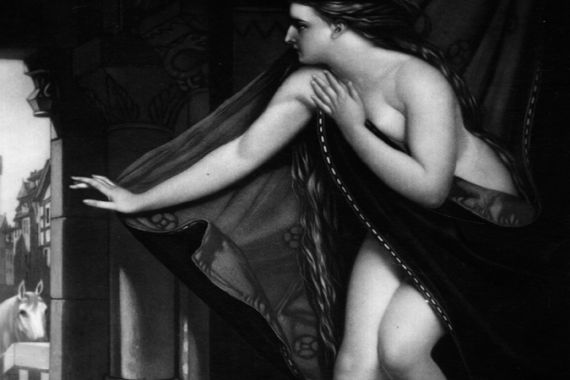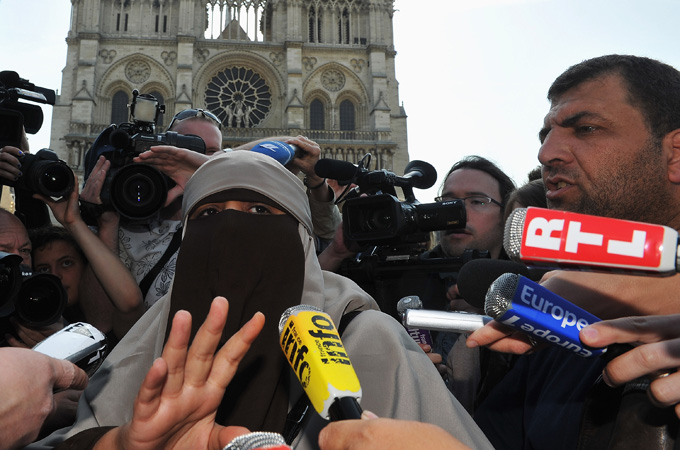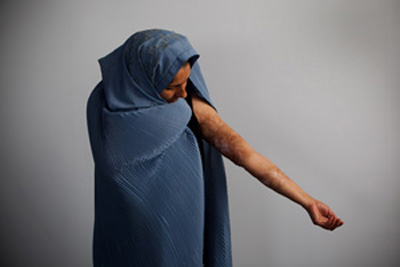La vita nuda: Baring bodies, bearing witness
Many young men and women are now protesting by the only means left: using their bodies – whether by burning or exposing.

 |
| Bodily resistance comes in the form of wearing the veil illegally in France, or not wearing it in Iran [GALLO/GETTY] |
New York, NY – Reflecting the public gesture of the Egyptian blogger Aliaa Magda Elmahdy, who posted naked pictures of herself late last year on her blog by way of a protest “against a society of violence, racism, sexism, sexual harassment and hypocrisy”, a young Iranian actress now living in France, Golshifteh Farahani, has recently created a sensation in and out of her homeland, especially in the social networking cyber society, by posing half naked for Madame Le Figaro, and also appearing topless in a short black-and-white video clip. It’s called “Corps et Ame/Bodies and Souls” and is produced by the prominent French fashion photographer and music video director Jean-Baptiste Mondino.
As with the case of Elmahdy and her compatriots, the nude picture and video clip of Farahani have sharply divided Iranians around the world; some celebrating her act as courageous, pathbreaking, dismantling ancient and sacrosanct taboos – and thus revolutionary, while others condemning her as opportunistic, obscene, immoral and damaging to the cause of liberty in Iran. The Islamic Republic has reportedly banned her from returning to her homeland.
Whence the outrage? In its widest sense, clothing is the civilising posture of humanity. No society, no community, no human gathering is devoid of one form of clothing or another as the formal decorum of becoming a full and public human being: it might be as little as a mere bamboo sheath around the groin or it might extend to fully covered veiling, without even the eyes visible to any intruding gaze. But clothing of one sort or another is definitive to all forms of civility.
Our manner of dressing ourselves is the most immediate habitat of our humanity – violently disrupted at times by tyrants who sought to give a different look to that humanity. When Reza Shah (who reigned in Iran from 1925 to 1941) banned the mode of “veiling” in Iran he had deemed unseemly to his vision of “modernity”, there were women who remained home and never appeared in public until their dying day – because for them to appear in public without their habitual clothing was like forcing New Yorkers to go to work in their bikinis.
When Khomeini re-imposed that almost-forgotten manner of veiling decades later, generations of women had grown up entirely alien to that manner of veiling. Reza Shah and Khomeini – two tyrants interrupted by one weakling potentate – had fought their fateful battles over the site of our mothers’ and daughters’ bodies.
‘Offensive’ content
Posing a body beneath or beyond its habitual habitat is disruptive in varied cultures – not just in Iran or the Muslim world. Even in the heart of Europe, when a website publishes an article about Golshifteh Farahani’s photos it does so with the alert: “WARNING: contains nudity”. These warnings are not intended for any cleric in Qom or Najaf, but for people in Western Europe or North America who might find these pictures “offensive”.
Entering Saint Peter’s Basilica in the Vatican City in the heart of Rome requires women to have “proper attire”, as does entering any mosque in Qom or Isfahan. When Janet Jackson’s breast was accidentally exposed during a duet with Justin Timberlake at the Superbowl in 2004, it caused as much uproar in the United States as it might have had in Saudi Arabia.
 |
| Deliberately burning oneself is just one form of desperate bodily resistance [GALLO/GETTY] |
In varied cultures around the globe, bodies and faces are painted, covered with cloth or leaves, or else hairs dyed, noses, lips and cheeks surgically altered, colourful contact lenses placed over black eyes, etc, all as the mannered rituals of societal acceptance and formality.
Dressing is the ceremonial ritual to present the body in public: From the “Sunday Best” to “dressed to the nines”, to “dressed to a tee”, to “three-piece suits” all the way down to “Friday dressing down”; from academic regalia to “heroin chic”, from the metrosexual to Calvin Klein androgynies, from Muslim veiling to Gap and Benetton advertisements, people clothe themselves by way of walking into the formal gathering of their public persona. No one is ever completely naked – not even in many naturist colonies.
Those who dismiss or ridicule formal dressings of varied cultures are entirely oblivious to how fanatically committed to their own “casual” look they are. All you have to do is to force them to wear a tie to a meeting and they cry out loud for their Gap t-shirt and blue jeans.
‘Nor customary suits of solemn black’
This is all to say that no culture, Muslim or otherwise, is naked – all cultures clothe – sacred or secular, Eastern or Western.
But (and there is the rub) the deliberate stripping of clothing a culture has habitually called “decent” – in gestures ranging from running naked in a soccer stadium with joy, or in protest, to highly stylised photograph or video installations – is an act of staged formal destruction that disrupts the “normality” of socialising norms for a deliberate pause. It is the staging of the body for a momentary reflection. The vast and varied tradition of nude statues, paintings and photographs, from the Greeks to the postmodern, are aesthetic pauses for such reflection and do not mean that the Greeks and Romans, or contemporary Europeans or Americans, ordinarily walk around their towns looking like those statues or pictures.
Art is a remissive occasion that, in effect, sustains a culture’s inhibitions – not discrediting or dismantling them (if we were to follow Phillip Rieff’s theory of culture to its logical conclusions).
Golshifteh Farahani is not the first young Iranian woman in recent memory to have taken a naked photo and publicised it – nor was Aliaa Magda Elmahdy the first Muslim to do so. Long before them, another young Iranian woman, Minou Arjomand, joined an HIV/AIDS advocacy group (ACT UP) for a top-to-toe naked demonstration outside Madison Square Garden in New York City, where the Republican National Convention was taking place in August 2004, protesting against President Bush’s AIDS policies. She and her friends later posed for a group portrait that was published in the New Yorker magazine.
Minou Arjomand’s gesture in New York was far more daring, imaginative and politically purposeful than Golshifteh Farahani and Aliaa Magda Elmahdy in Paris and Cairo put together. But scarcely anyone in the Iranian or Muslim community noted that picture in August 2004 – or even knows about it now – taken, as it was, before online social networking had turned the world inside out. Minou Arjomand joined that group portrait in protest at President Bush’s HIV/AIDS policies without any pomp or ceremony, and without the slightest publicity drawn to that photo beyond the limited HIV/AIDS epidemic activist circles.
|
“These are transgressive moments that expose and shatter the ruling inhibitions – from the stigma of the HIV/AIDS epidemic to the indignity of mandatory veiling to the horrors of unemployment to unbearable political tyranny.“ |
But it is precisely by opening the frame of reference back at least to that picture (politically purposeful, but far from the madding crowd of internet publicity) that the recent actions of Golshifteh Farahani and Aliaa Magda Elmahdy will make more sense (albeit in rather different political contexts). Breaking the taboo of HIV/AIDS by baring bodies and bearing witness in the United States was no less iconoclastic or courageous than baring bodies and bearing witness against tyranny and repression in Egypt or Iran.
There are other, similarly dramatic, but far more fatal, gestures perpetrated on one’s own body that also need to be included in this frame.
Public protest can assume fatal acts of self-immolation, as in the case of Mohamed Bouazizi in Tunisia that set the Arab Spring aflame, or when even more young unemployed men setting themselves on fire in Morocco. The bodily gesture can also assume less fatal turns but equally shocking to the reigning taboos, as in the cases of Elmahdy, Farahani or Arjomand.
These are transgressive moments that expose and shatter the ruling inhibitions – from the stigma of the HIV/AIDS epidemic to the indignity of mandatory veiling to the horrors of unemployment to unbearable political tyranny.
But in the age of the “society of spectacle” (Guy Debord’s idea) having gone amuck, one must by all means resist fetishising a single act of nudity going viral on the internet. For exposing one’s body by way of protesting against political tyranny does not mean that if other Iranian or Muslim women opt to wear their habitual veiling they are in agreement with the ruling tyranny.
The Eurocentric Neoliberalism now rampant among certain vocal segments of expatriate Iranians equates “liberation” with such acts of anti-veiling defiance, which the Islamophobic Europe and US then picks up and trumpets ad nauseum. That equation of extreme unveiling with “liberation” or even “defiance” is a patently false equation. There are courageous Muslim women fighting valiantly for their liberties, or else suffering in the dungeons of the Islamic Republic, who voluntarily and happily opt to veil. Farahani’s half-naked body is as dignified an act of defiance as her sisters’ veiled bodies in the dungeons of the Islamic Republic.
Beyond its Eurocentric, white-identified and Neoliberal appropriation in “the society of spectacle”, la vita nuda, public gestures such as those of Elmahdy or Farahani exposes the amorphous site of contestation between the violence that states perpetrate (whether forced veiling in the Islamic Republic or forced unveiling in France) and resistances that bodies pose. No defence of Farahani’s courageous gesture in France is thus complete without ipso facto defending the right of immigrant Muslim women to veil in public in Europe if they so choose.
In the age of globalised capital and aterritorial empires, bodies have emerged as the singular site of resistance to power – from suicidal violence around the globe to young women exposing their bodies to shock and awe of a different sort. In a world which commenced with former US Secretary of State Ronald Rumsfeld’s “campaign of shock and awe”, and continued with the raping of the human dignity on an everyday scale in detention camps from Guantanamo Bay to Bagram Airbase, from Israeli dungeons to Kahrizak and Evin in the Islamic Republic, these exposed bodies register the always already vulnerable human soul.
The systematic reduction of life to biopolitics is done entirely beneath the radar of the instantaneous publicities that accompany such widely publicised acts as those of Elmahdy or Farahani. When Agamben theorised the contours of the homo sacer – of the reduction of the civil persona to “bare life” in the society of spectacle and in a “state of exception” that has become the rule, he had already seen through the transformation of civic societies into camps as the nomos of the modern. The fact that the Green Movement in Iran or the Arab Spring in the Arab world is recasting the moral map of the region does not mean we have overcome that frightful spectre.
‘I have that within which passed show’
There is scarcely anything palpably erotic about Farahani’s naked photo, or even about Elmahdy’s. These are, above all, fragile and vulnerable bodies posing to defy generations of tyranny upon their souls. As a father of four children (two daughters, one of them as old as Arjomand, Elmahdy and Farahani), my first reaction to their pictures has been a paternal sense of protection – protection not against uninvited gazes (of which they are perfectly capable of doing themselves when and if they so choose) but protection of their freedom to revolt. Precisely at the moment that you applaud their purposeful and dignified steadfastness and determination to alter the course of their communal history, it is the dignity of their revolt that matters most.
|
“These pictures are not acts of obscentity … these are gestures of innocence incarnate.“ |
Minou Arjomand, Golshifteh Farahani or Aliaa Magda Elmahdy’s photos are the insignia of an age, postmarks from a universal act of defiance. If anything, these pictures are to be compared with the picture of that young Egyptian woman being beaten and dragged by security forces in Tahrir Square, involuntarily exposing her body and underwear – or with the picture of the Yemeni women burning their veils in public protest. The protection of that right to revolt is in anticipation of that liberating moment when these protesters, just like “the Vancouver kissing couple” will have the choice of a simple and perfectly human act of love overcoming an obscene act of riot police brutality.
These pictures are not acts of obscenity. Quite to the contrary: these are gestures of innocence incarnate. Obscenity is the exposure of human body and soul in the torture chambers of Abu Ghraib, Bagram Air Base, Guantanamo Bay, the dungeons of Isareli prison cells, all the way to Kahrizak and other subterranean cells of the Islamic Republic. That is obscenity, not these innocent children baring their soul in protest. Obscene is the shape of the world that we, as parents, have handed to our children. Obscenity is the degeneration of civil society and common civility to detention camps in the US and barefacedly robbing people of their most basic civil liberties in the Islamic Republic – and as the two belligerent states pose to fight each other, they rob their respective citizens even more of their civil liberties. That’s the obscenity.
These young men and women are protesting by the only means left to them – the site of their bodies, blowing it up in Palestine, Iraq or Afghanistan, burning it to ashes in Tunisia or Morocco, exposing its fragile innocence in Egypt or else in exile in Europe or the United States.
As an Iranian and a Muslim father I am very proud of Golshifteh Farahani and Aliaa Magda Elmahdy, as I was of Minou Arjomand, and salute their courage and imagination. They have neither waited for, nor do they need, their parental approval. And our task is not to approve or disapprove of what they have done. We are, as their parents, here to protect their freedom to revolt, and thus to bear witness, so that one day they can explain to their children, not to their parents, what it is they have done.
Meanwhile, to bear witness: territorial boundaries are no longer the solitary sites of resistance to political violence and tyranny – our naked bodies, whether we expose or hide them, have become the last remaining corporeality that matters and means. Mohamed Bouazizi opted to burn himself alive, Golshifteh Farahani and Aliaa Magda Elmahdy to stage themselves – but common to their acts is not just the fragile bodies of these young protesters, but the fact that their ruling emperors, corrupt kings and clerics from one end of the Arab and Muslim world to another, have long been walking around with their pants down.
Hamid Dabashi is Hagop Kevorkian Professor of Iranian Studies and Comparative Literature at Columbia University in New York. His edited volume, Dreams of a Nation: On Palestinian Cinema was published by Verso in 2007. His forthcoming book, The Arab Spring: The End of Post-Colonialism, is scheduled for publication by Zed in April 2012.
The views expressed in this article are the author’s own and do not necessarily reflect Al Jazeera’s editorial policy.
